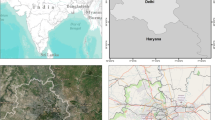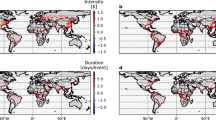Abstract
Previous studies examining future changes in heat/cold waves using climate model ensembles have been limited to grid cell-average quantities. Here, we make use of an urban parameterization in the Community Earth System Model (CESM) that represents the urban heat island effect, which can exacerbate extreme heat but may ameliorate extreme cold in urban relative to rural areas. Heat/cold wave characteristics are derived for U.S. regions from a bias-corrected CESM 30-member ensemble for climate outcomes driven by the RCP8.5 forcing scenario and a 15-member ensemble driven by RCP4.5. Significant differences are found between urban and grid cell-average heat/cold wave characteristics. Most notably, urban heat waves for 1981–2005 are more intense than grid cell-average by 2.1 °C (southeast) to 4.6 °C (southwest), while cold waves are less intense. We assess the avoided climate impacts of urban heat/cold waves in 2061–2080 when following the lower forcing scenario. Urban heat wave days per year increase from 6 in 1981–2005 to up to 92 (southeast) in RCP8.5. Following RCP4.5 reduces heat wave days by about 50 %. Large avoided impacts are demonstrated for individual communities; e.g., the longest heat wave for Houston in RCP4.5 is 38 days while in RCP8.5 there is one heat wave per year that is longer than a month with some lasting the entire summer. Heat waves also start later in the season in RCP4.5 (earliest are in early May) than RCP8.5 (mid-April), compared to 1981–2005 (late May). In some communities, cold wave events decrease from 2 per year for 1981–2005 to one-in-five year events in RCP4.5 and one-in-ten year events in RCP8.5.





Similar content being viewed by others
References
Anderson GB, Bell ML (2011) Heat waves in the United States: mortality risk during heat waves and effect modification by heat wave characteristics in 43 U.S. communities. Environ Health Perspect 119:210–218
Collins M, Knutti R, Arblaster J, et al (2013) Long-term climate change: projections, commitments and irreversibility. In: Stocker TF, Qin D, Plattner G-K, et al (eds) Climate change 2013: the physical science basis. Contribution of Working Group I to the Fifth Assessment Report of the Intergovernmental Panel on Climate Change. Cambridge University Press, Cambridge, United Kingdom and New York, NY, USA
Conti S, Meli P, Minelli G, et al (2005) Epidemiologic study of mortality during the summer 2003 heat wave in Italy. Environ Res 98:390–399
Coumou D, Robinson A (2013) Historic and future increase in the global land area affected by monthly heat extremes. Environ Res Lett 8:034018
Diffenbaugh NS, Ashfaq M (2010) Intensification of hot extremes in the United States. Geophys Res Lett 37:L15701. doi:10.1029/2010GL043888
Dixon PG, Brommer DM, Hedquist BC, et al. (2005) Heat mortality versus cold mortality: a study of conflicting databases in the United States. B Am Meteorol Soc 86:937–943
Fischer EM, Beyerle U, Knutti R (2013) Robust spatially aggregated projections of climate extremes. Nat Clim Chang 3:1033–1038
Gao Y, Fu JS, Drake JB, et al (2012) Projected changes of extreme weather events in the eastern United States based on a high resolution climate modeling system. Environ Res Lett 7:044025
Girvetz EH, Maurer E, Duffy P et al (2012) Making climate data relevant to decision making: the important details of spatial and temporal downscaling. The World Bank Group. http://sdwebx.worldbank.org/climateportal. Accessed 01 October 2014
Guirguis K, Gershunov A, Tardy A, Basu R (2014) The impact of recent heat waves on human health in California. J Appl Meteorol Clim 53:3–19
Hawkins E, Sutton R (2009) The potential to narrow uncertainty in regional climate predictions. B Am Meteorol Soc 90:1095–1107
Hurrell JW, Holland MM, Gent PR, et al (2013) The community earth system model: a framework for collaborative research. B Am Meteorol Soc 94:1339–1360. doi:10.1175/bams-d-12-00121.1
Jackson TL, Feddema JJ, Oleson KW, et al (2010) Parameterization of urban characteristics for global climate modeling. A Assoc Am Geog 100:848–865
Kay JE, Deser C, Phillips A, et al (2014) The community earth system model (CESM) large ensemble project: a community resource for studying climate change in the presence of internal climate variability. B Am Meteorol Soc 96:1333–1349. doi:10.1175/bams-d-13-00255.1
Kosaka Y, Xie S-P (2013) Recent global-warming hiatus tied to equatorial Pacific surface cooling. Nature 501:403–407
Lawrence DM, Oleson KW, Flanner MG et al (2011) Parameterization improvements and functional and structural advances in version 4 of the community land model. J Adv Model Earth Syst 3:M03001. doi:10.1029/2011MS000045
McGinnis S, Nychka D, Mearns LO (2015) A new distribution mapping technique for climate model bias correction. In: Lakshmanan V, Gilleland E, McGovern A, Tingley M (eds.) Machine Learning and Data Mining Approaches to Climate Science: Proceedings of the Fourth International Workshop on Climate Informatics, Springer. doi:10.1007/978-3-319-17220-0_1
Medina-Ramón M, Schwartz J (2007) Temperature, temperature extremes, and mortality: a study of acclimatisation and effect modification in 50 US cities. Occup Environ Med 64:827–833
Meehl GA, Tebaldi C (2004) More intense, more frequent, and longer lasting heat waves in the 21st century. Science 305:994–997
Mishra V, Ganguly AR, Nijssen B, Lettenmaier DP (2015) Changes in observed climate extremes in global urban areas. Environ Res Lett 10:024005
Monier E, Gao X (2014) Climate change impacts on extreme events in the United States: an uncertainty analysis. Clim Chang. doi:10.1007/s10584-013-1048-1
Monier E, Gao X, Scott JR, et al. (2014) A framework for modeling uncertainty in regional climate change. Clim Chang. doi:10.1007/s10584-014-1112-5
Oleson KW (2012) Contrasts between urban and rural climate in CCSM4 CMIP5 climate change scenarios. J Clim 25:1390–1412
Oleson KW, Monaghan A, Wilhelmi O, et al (2013) Interactions between urbanization, heat stress, and climate change. Clim Chang. doi:10.1007/s10584-013-0936-8
Peng RD, Bobb JF, Tebaldi C, et al (2011) Toward a quantitative estimate of future heat wave mortality under global climate change. Environ Health Perspect 119:701–706
Perkins SE, Fischer EM (2013) The usefulness of different realizations for the model evaluation of regional trends in heat waves. Geophys Res Lett 40:2013GL057833 doi:10.1002/2013gl057833
Peterson TC, Heim Jr RR, Hirsch R, et al (2013) Monitoring and understanding changes in heat waves, cold waves, floods, and droughts in the United States: state of knowledge. B Am Meteorol Soc 94:821–834
Rienecker MM, Suarez MJ, Gelaro R, et al (2011) MERRA: NASA’s modern-era retrospective analysis for research and applications. J Clim 24:3624–3648
Seneviratne SI, Donat MG, Mueller B, Alexander LV (2014) No pause in the increase of hot temperature extremes. Nat Clim Chang 4:161–163
Smith TT, Zaitchik BF, Gohlke JM (2013) Heat waves in the United States: definitions, patterns and trends. Clim Chang 118:811–825
Stone Jr B (2007) Urban and rural temperature trends in proximity to large US cities: 1951–2000. Int J Clim 27:1801–1807
Stone B (2012) The city and the coming climate: climate change in the places we live. Cambridge University Press, New York
Thrasher B, Maurer EP, McKellar C, Duffy PB (2012) Technical note: bias correcting climate model simulated daily temperature extremes with quantile mapping. Hydrol Earth Syst Sci 16:3309–3314
van Vuuren DP, Edmonds J, Kainuma M, et al. (2011) The representative concentration pathways: an overview. Clim Chang 109:5–31
Wang A, Zeng X (2013) Development of global hourly 0.5° land surface air temperature datasets. J Clim 26:7676–7691
Acknowledgments
This material is based upon work supported by the National Science Foundation (NSF) under Grant Number AGS-1243095. K.W. Oleson was supported in part by NASA grant NNX10AK79G (the SIMMER project) and the NCAR Weather and Climate Impacts Assessment Science Program (WCIASP). G.B. Anderson was supported by NIEHS grants K99ES022631 and R21ES020152. We thank C. Tebaldi and B. O’Neill for comments on an earlier draft of this paper, and J.-F. Lamarque for useful discussions about heat/cold waves. We thank the reviewers for their insightful and constructive comments that substantially improved the manuscript. NCAR is sponsored by the NSF.
Author information
Authors and Affiliations
Corresponding author
Additional information
This article is part of a Special Issue on “Benefits of Reduced Anthropogenic Climate changE (BRACE)” edited by Brian O’Neill and Andrew Gettelman.
Electronic supplementary material
ESM 1
(DOCX 2983 kb)
Rights and permissions
About this article
Cite this article
Oleson, K.W., Anderson, G.B., Jones, B. et al. Avoided climate impacts of urban and rural heat and cold waves over the U.S. using large climate model ensembles for RCP8.5 and RCP4.5. Climatic Change 146, 377–392 (2018). https://doi.org/10.1007/s10584-015-1504-1
Received:
Accepted:
Published:
Issue Date:
DOI: https://doi.org/10.1007/s10584-015-1504-1




